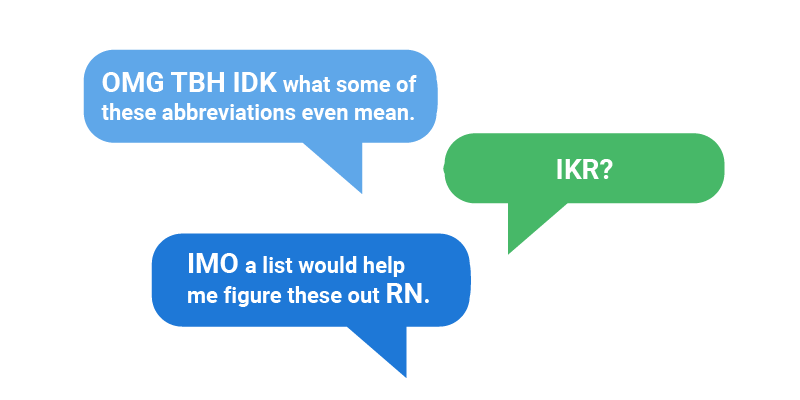Your Guide to the Most Common Physical Therapy Abbreviations

No matter what setting you work in, you likely encounter physical therapy abbreviations on a regular basis—but it’s not always easy to keep them all straight, and new ones are seemingly created every day. Yet in an environment where clear communication is essential, a misunderstood abbreviation could be dangerous.
With that in mind, here’s a list of some of the more common cross-setting physical therapy abbreviations. There will never be a truly exhaustive list, and your own setting likely has its own unique shorthand, but this collection should give you a strong foundation.
Common Clinical and Non-Clinical Physical Therapy Abbreviations
Clinical Abbreviations
A
AAROM: Active assisted range of motion
ABD: Abduction
AC: Acromioclavicular joint
ACDF: Anterior cervical discectomy and fusion
ADD: Adduction
ADL: Activities of daily living
AFO: Ankle foot orthotic
AKA: Above knee amputation
AP: Anterior to posterior
APTA: American Physical Therapy Association
AROM: Active range of motion
B
BAPS: Biomechanical ankle platform system
BFRT: Blood flow restriction training
BID/BIW: Twice a day/Twice a week
BKA: Below knee amputation
b/l: Bilateral
BOS: Base of support
BOS: Beginning of session
BP: Blood pressure
BPPV: Benign paroxysmal positional vertigo
C
cc: Cable column
CCP: Cervical cold pack
CHP: Cervical hot pack
CP: Cold pack
cx: Cancel
CX or CS: Cervical spine
D
DA: Direct access
DB: Dumbbell
DDD: Degenerative disc disease
DFM: Deep friction massage
DJD: Degenerative joint disease
DKTC: Double knee to chest
DLS: Double limb support
DNF: Deep neck flexors
E
ECG or EKG: Electrocardiogram
EDS: Ehlers-Danlos syndrome
EIL: Extension in lying
EIS: Extension in standing
EOB: Edge of bed
EOS: End of session
ER: External rotation
ES: Electrical stimulation
F
FAI: Femoroacetabular impingement
FIL: Flexion in lying
FIS: Flexion in standing
FMS: Functional movement screen
FOB: Foot of bed
FOM: Functional outcome measure
G
GH: Glenohumeral joint
GIRD: Glenohumeral internal rotation deficit
H
HABD: Horizontal abduction
HADD: Horizontal adduction
HBB: Hand behind back
HEP: Home exercise program
HOB: Head of bed
HP: Hot pack
HR: Heart rate
Hx: History of
I
IASTM: Instrument-assisted soft tissue mobilization
IM: Intramuscular
IM: Intramedullary
IPC: Intermittent pneumatic compression
IR: Internal rotation
IV: Intravenous
J
JAMAR: Hand/grip dynamometer
K
KTC: Knee to chest
L
LCP: Large cold pack
LHP: Large hot pack
LJL: Lateral joint line
LOB: Loss of balance
LOC: Loss of consciousness
LOS: Length of stay
LS or LX: Lumbar spine
LTG: Long-term goal
LTR: Lateral trunk rotation
M
MC: Medicare
MHP: Moist hot pack
MJL: Medial joint line
ML: Monthly letter
MTJ: Musculotendinous junction
MMT: Manual muscle test
MMT: Medial meniscus tear
MWM: Mobilization with movement
N
NMES: Neuromuscular electrical stimulation
O
O2: Oxygen
OA: Osteoarthritis
OH: Over head
ORIF: Open reduction internal fixation
P
PA: Posterior to anterior
PB: Physioballs
PD: Parkinson’s disease
PFJ: Patellofemoral joint
PMHx: Past medical history
POC: Plan of care
PRN: As needed
PROM: Passive range of motion
PRP: Platelet-rich plasma
Pt: Patient
PVM: Paravertebral muscles
R
RA: Rheumatoid arthritis
RC: Rotator cuff
RCR: Rotator cuff repair
RCT: Rotator cuff tear
RE: Re-evaluation of patient
RFMD: Return from MD
ROM: Range of motion
ROT: Rotation
RTMD: Return to MD
RTS: Return to sport
RTSA/RTSR: Reverse total shoulder arthroplasty/replacement
RTW: Return to work
S
SAD: Subacromial debridement
SB: Side bend
SC: Sternoclavicular joint
SG: Side glide
SGIS: Side glide in standing
SI or SIJ: Sacroiliac joint
SKTC: Single knee to chest
S/L: Side lying
SLAP: Superior labrum anterior to posterior
SLJ: Sinding-Larsen-Johansson syndrome
SLS: Single limb support
SNAG: Sustained natural apophyseal glide
SOR: Suboccipital release
s/p: Status post
SpO2: Oxygen saturation as per pulse oximeter
STG: Short-term goal
STM: Soft tissue mobilization
T
TA: Transverse abdominis
TB: Theraband
TC: Talocrural
TENS: Transcutaneous electrical stimulation
THA/THR: Total hip arthroplasty/replacement
TID/TIW: Three times a day/three times a week
TKA/TKR: Total knee arthroplasty/ replacement
TM: Treadmill
TMD: Temporomandibular disorder
TMJ: Temporomandibular joint
TSA/TSR: Total shoulder arthroplasty/replacement
TTP: Tender to palpation
U
US: Ultrasound
UBE: Upper body ergometer
V
VASTM: Vibration-assisted soft tissue mobilization
VOR: Vestibulo-ocular reflex
X
XFM: Cross-friction massage
Non-Clinical Abbreviations
Auth: Authorization
Cx: Cancel
DC: Discharge
Ded: Deductible
DN: Daily note
EMR: Electronic medical record
f/b: Followed by
f/u: Follow up
HC: Home care
IE: Initial evaluation
Ins: Insurance
IV: Insurance verification
l/m: Left message
MC: Medicare
ML: Monthly letter
n/s: No show for appointment
OON: Out of network
POC: Plan of care
PN: Progress note
RE: Re-evaluation
Don’t Forget to Confirm, Confirm, Confirm!
Across physical therapy, abbreviations are understandably popular for saving time—but they don’t come without a risk. For example, as you can see in the list above, some medical abbreviations (such as BOS) have multiple meanings, which can muddle clarity.
We hope this article helps you navigate abbreviations better and lower the risk of misunderstanding, but remember that whenever in doubt, confirming meaning via in-person communication is still essential for patient safety.










